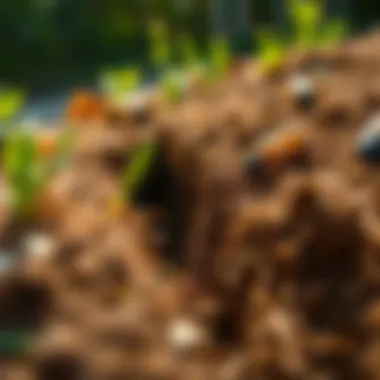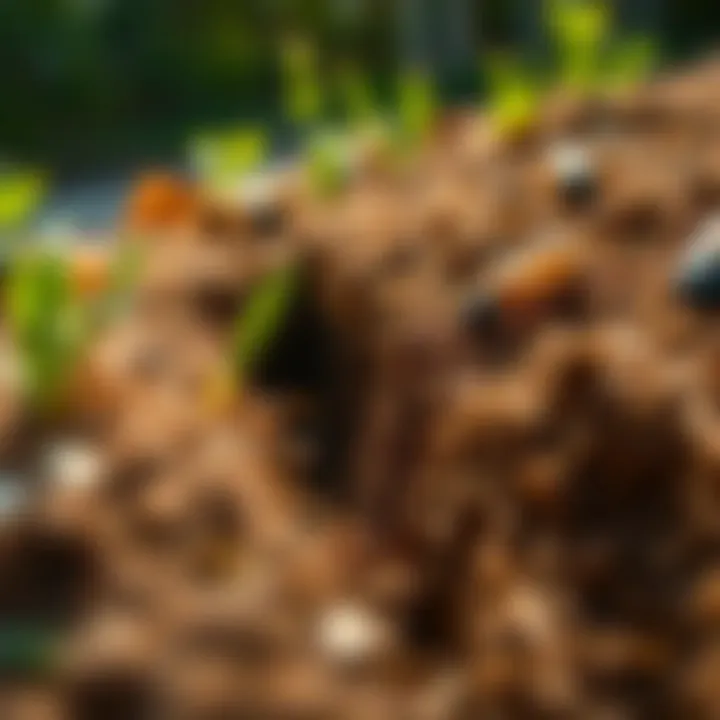Trenching for Termite Treatment: Method and Insights


Intro
In the shadowy corners of our homes, a silent menace may be lurking—termites. These insidious pests can wreak havoc on the structure of a house, leading to costly repairs and potential safety hazards. Therefore, understanding them is paramount for anyone looking to protect their residence.
This guide delves into trenching as a method for termite treatment, exploring its application, effectiveness, and environmental outcomes. We will navigate through the biological intricacies of termites, recognize the signs of infestation, and discuss effective preventative measures. Furthermore, this exploration will draw comparisons with other pest control techniques, providing a well-rounded perspective that is especially relevant for homeowners, pest control professionals, and the eco-conscious.
By equipping yourself with knowledge and practical insights, you’ll be fortified against the potential destruction of termites. Let’s embark on this journey to safeguard our homes.
Understanding the Pest
Termites are small insects, often mistaken for ants, that thrive on wood and other cellulose-based materials. They play a crucial role in our ecosystem by breaking down dead wood and recycling nutrients back into the soil, but their destructive potential makes them unwelcome guests in our homes.
Identification
Identifying termites can be tricky. They are social insects living in colonies, typically categorized into three types—workers, soldiers, and reproductive (swarmers). The workers, responsible for feeding and building the colony, are usually pale and measure about one-eighth an inch in length. Soldiers, on the other hand, possess larger jaws, used for defending the colony. Swarmers, which are winged, emerge primarily during spring, signaling potential expansion of their territory.
Common signs of termite presence include:
- Discarded wings around windows and doors
- Mud tubes along foundation walls
- Hollow-sounding wood when knocked
Life Cycle
Understanding the life cycle of termites provides insight into their behavior and reproductive strategies. The cycle begins with the swarmers, who mate during swarming flights. If conditions are right, they establish a new colony, eventually producing a queen capable of laying thousands of eggs per day. The different stages—egg, nymph, and adult—contribute to rapid colony growth, which is why early detection is crucial.
Pest Prevention Strategies
Preventing termite infestations is often more effective than treatment after the damage is done. With some small changes and proactive measures, homeowners can reduce the risk.
Environment Modification
Creating an environment unfriendly to termites involves minimizing moisture and food sources. Here are several steps to consider:
- Keep gutters clean to prevent water accumulation.
- Store firewood at least twenty feet away from the home and five inches off the ground.
- Repair leaky faucets and pipes promptly to limit water sources.
Physical Barriers
Installing physical barriers is another effective strategy against termites. These barriers can include
- Metal mesh or screens to block entry points
- Concrete foundations that terminate abruptly, denying access to wood structures
- Treated wood that insects find unappetizing
Control Methods
If prevention fails and termites invade, homeowners may need to resort to control methods to eliminate them. Two primary approaches include chemicals and biological control.
Chemical Control
Chemical treatments, particularly liquid insecticides known as termiticides, are a common method used to establish chemical barriers against termites. These can be applied during construction or as a treatment for existing homes. It's essential to select a reputable product and have it applied by a licensed pest control professional.
Biological Control
An eco-friendly alternative is biological control which employs natural predators or parasites to manage termite populations. Beneficial nematodes, for example, can invade termite colonies and help reduce numbers effectively.
Effective pest management is a blend of prevention, control methods, and continuous monitoring.
For further detailed guidelines, visit USDA and EPA.
This section lays the groundwork for understanding termite behavior, thus creating a foundation upon which more intricate pest control strategies, like trenching, can be effectively discussed later.
Understanding Termite Infestations
Termites, often dubbed the silent destroyers, can wreak havoc on homes if left unchecked. Understanding termite infestations is the cornerstone of effective pest management. Delving into the complexities of these critters is crucial, not only to prevent damage but also to safeguard investments and maintain the structural integrity of homes.


The Biology of Termites
Termites belong to the order Blattodea, which also includes cockroaches. They are social insects that live in colonies that can range from a few hundred to several million individuals. The colony typically consists of a queen, king, workers, and soldiers. Workers are the unsung heroes of the colony; they forage for food, build and maintain the nest, and care for the young. Soldiers, equipped with strong jaws, protect the colony from predators.
Termites primarily feed on cellulose, a component found in wood, paper, and other plant materials. This cellulose digestion is facilitated by symbiotic microorganisms in their guts. Interestingly, different species of termites have distinct feeding habits; for example, subterranean termites live in the soil, while drywood termites inhabit the wood they consume. Recognizing these behavioral patterns can aid in identifying their presence in your home.
Common Signs of Infestation
Detecting a termite infestation early is key to managing it effectively. Here are some common signs to watch out for:
- Mud Tubes: These pencil-sized tunnels made from soil and saliva enable termites to travel between their nest and food sources.
- Discarded Wings: After mating, termites shed their wings. Spotting these discarded wings, typically around windows and doors, may indicate a swarm.
- Hollowed-out Wood: If you tap on wood and it sounds hollow, it might be a sign that termites have done their work. Also, visible frass, or termite droppings, can signal their presence.
- Swarmers: During certain seasons, reproductive termites will swarm in search of a new place to establish a colony. Seeing these insects indoors is a clear warning sign.
Being vigilant is essential. Homeowners should conduct regular inspections and reach out for professional help if the above signs appear.
The Economic Impact of Termite Damage
Termite damage is not just a nuisance; it can have serious financial implications. In the United States alone, termites cause approximately $5 billion in property damage each year, according to the National Pest Management Association. These costs are often not covered by homeowners' insurance.
Damage can result in structural issues, leading to costly repairs and decreased property values. Additionally, infestations can lead to legal disputes if the damage is not disclosed during real estate transactions.
On top of direct repairs, the emotional toll of dealing with infestations can be overwhelming for homeowners. The stress of uncertainty, paired with financial implications, makes a genuine understanding of termite infestations not just beneficial, but necessary.
"Preventing a termite invasion is far more cost-effective than the cure. Awareness is the first step in this battle."
In summary, comprehending termite infestations is vital for homeowners. This understanding not only helps to detect and address issues early but also protects investments and peace of mind.
Preamble to Trenching Termite Treatment
Understanding trenching as a method for termite treatment is crucial for homeowners facing the threat of these insidious pests. Termites may seem unassuming, but their ability to cause extensive damage can go unnoticed until it's too late. Trenching offers an effective solution to combat termite infestations, addressing both existing problems and preventive measures.
What is Trenching?
Trenching involves the excavation of a narrow channel around a structure to apply a termiticide that creates a barrier against termite intrusion. This process is particularly effective against subterranean termites, which thrive in soil and can infiltrate homes from below. The trench itself is typically about six inches wide and extends at least six inches deep, ensuring the treatment reaches the main colony in the soil.
The process starts with a detailed assessment of the property to determine the extent of the infestation and the locations of termite activity. It’s not a slapdash approach; rather, it’s a targeted effort designed to halt termite movement and protect your home for the long haul. Homeowners appreciate trenching not only for its effectiveness but also for the relative ease with which it can be executed, particularly when compared to other, more invasive treatment methods.
History and Evolution of the Technique
Trenching has been around longer than most may realize. The concept can be traced back to the early 20th century when pest control methods were still in their infancy. Initially, treatments largely relied on arsenic-based compounds, which were both dangerous and toxic. As regulations tightened, the pest control industry began seeking safer alternatives.
By the 1980s, advancements in chemistry led to the development of lower-toxicity termiticides, making trenching a more viable option. The introduction of these eco-friendlier agents not only improved safety but also increased efficiency, allowing homeowners to take a stand against termite invasion without putting their loved ones at risk. Today, trenching has become a preferred method due to its effectiveness in preventing and mitigating infestations across various environments.
In summary, trenching has evolved into a reliable, safe, and effective means of termite treatment. As we dive further into the trenching process and compare its efficacy with alternative methods, it becomes clear that trenching plays a significant role in integrated pest management strategies. By understanding its historical context and current applications, homeowners can make informed decisions in their battle against termites.
The Trenching Process
The trenching process is a critical component of termite treatment, offering a targeted approach to manage infestations effectively. This methodology is not just about digging a hole in the ground; it requires strategic planning and execution to be successful. By understanding this process, homeowners can enhance their pest management efforts, reduce the risk of future infestations, and preserve the integrity of their property. The effectiveness of trenching hinges on meticulous preparation, the right techniques for digging, and the appropriate application of treatment substances. Each of these stages contributes to achieving the desired outcome—the eradication of termites from your environment.
Site Preparation and Assessment
Before any dirt is disturbed, site preparation is paramount. This phase involves a thorough assessment of the property to identify potential problem areas. Homeowners should look for signs of termite activity, such as mud tubes, damaged wood, or discarded wings.
- Identifying Infestation Sources: It’s essential to pinpoint where termites are entering the property. Sometimes, this may involve checking near foundations, around piping, or under mulch in garden areas.
- Evaluation of Soil Conditions: The type of soil can significantly affect the trenching results. Sandy soil, for example, holds moisture differently than clay, impacting how treatments are absorbed.
- Safety Considerations: Before digging, also gather relevant information about underground utilities. Calling the local utility company for markings can prevent damage and ensure safety during the trenching operation.
"A well-prepared site lays the foundation for effective termite control; details matter!"
Methods of Digging Trenches
Once the site is ready, the next step is choosing how to dig the trenches. By knowing the characteristics of your yard, you can select the most suitable method.
- Hand Digging: This traditional method is useful for smaller areas and gives you direct control over trench depth and width.
- Mechanical Excavation: For larger infestations, using a motorized trencher can save time and effort. This machine can create consistent trenches quickly, often making it easier to apply treatments efficiently.
- Trench Dimensions: Generally, trenches should be around six inches wide and up to four feet deep, ensuring that they adequately reach the termite pathways below the surface. Assessing whether this fits your yard’s design is essential.
Applying Treatment Alternatives


With trenches in place, applying the right treatment alternative is crucial for effectiveness. Several options are available, each with different benefits and considerations.
- Chemical Treatments: These involve using termiticides that destroy or repel termites. It’s essential to choose products that suit your soil type and comply with local regulations.
- Physical Barriers: Some homeowners opt for physical barriers, like metal mesh or sand barriers, that prevent termites from crossing into the structure.
- Baiting Systems: Used as a supplementary method or standalone treatment, baiting systems can attract and kill termites. Placing these strategically near infested areas can help reduce their numbers significantly.
In concluding the trenching process, it is vital to follow up on the areas treated, assessing the effectiveness of your methods, and ensuring ongoing protection against future infestations. Each phase informs the next, creating a comprehensive approach to termite management.
Efficacy of Trenching Techniques
The efficacy of trenching techniques in combating termite infestations holds paramount importance for homeowners and pest control professionals alike. Effective trenching not only targets termites efficiently but also plays a vital role in the long-term management of these invasive pests. Understanding the nuances behind these methods can bolster preventative measures, ensuring a termite-free environment while protecting one's property from potential economic repercussions.
Factors Influencing Treatment Success
There are several factors that influence the success rate of trenching as a termite treatment. Here are the key elements:
- Soil Composition: Different types of soil can impact how well the treatment is absorbed and distributed. Sandy soils, for instance, allow for quicker drainage, which might result in less effectiveness when trying to keep the insecticides in place. In contrast, clay-rich soils retain moisture but could complicate the application process.
- Depth and Width of Trenches: The dimensions of the trench being dug are also critical. Trenches must be of optimal depth and width to effectively deliver the insecticide to the termite colonies. A trench that is too shallow may not reach the targeted depth where termites reside, while an overly wide trench may dilute the treatment.
- Application Techniques: How the treatment is applied plays a crucial role. Injections into the trench should ensure even distribution, avoiding gaps that could allow termites to breach the barrier. Professional pest control typically employs specialized equipment to achieve precision that may be hard for DIY methods to replicate.
"Effective trenching is not just about digging—it's about digging smartly."
- Environmental Conditions: Weather factors such as rain can affect the success of trenching methods. Heavy rainfall can wash away applied treatments, making them less effective. It’s best to apply treatments during dry spells to ensure the best outcomes.
Each of these factors underscores the importance of a tailored approach to trenching techniques, suggesting that a one-size-fits-all strategy could lead to less effective results.
Comparative Effectiveness Against Other Methods
When comparing trenching techniques to other methods of termite control, several aspects emerge, painting a clearer picture of why trenching may be a preferred option:
- Long-Term Protection: Trenching is often seen as a long-lasting solution since it creates a physical and chemical barrier against termites at the area where they most often gain entry into structures. Other methods, such as baiting systems, may require ongoing monitoring and refill of bait, which can become tedious and costly over time.
- Targeted Application: Trenching allows for targeted application directly in the areas where termites are most active. In contrast, some widespread application methods can lead to unnecessary chemical use, which could harm non-target organisms and compromise local ecosystems.
- Lower Risk: Techniques like spraying pesticides can pose health risks to humans and pets if proper precautions aren’t taken. Trenching minimizes exposure, as the treatment is contained within the ground.
- Effectiveness of Insecticides: Research has shown that certain termiticides used in trenching have higher efficacy rates than those employed in liquid spray applications. This ensures that not only are termites killed upon contact, but the chemical also remains effective over time, continuously protecting the property.
For homeowners and professionals, understanding these comparative advantages will help in making informed decisions when selecting the appropriate methodology to protect against termites. Moreover, it emphasizes the necessity of considering trenching as a potentially more effective option in the overarching strategy against termite infestations.
For further reading on pest control methods, consider checking out resources like University of California Agriculture and Natural Resources which provides detailed insights into pest management practices.
Environmental Considerations
When tackling the issue of termites, it’s vital to consider the environmental aspects of treatment methods, particularly trenching. This technique doesn’t merely focus on the pests themselves; it also addresses the broader ecological ramifications of pest control. Recognizing the importance of minimizing environmental impact can lead to more sustainable and effective pest management strategies that protect our homes and surroundings alike.
Impact on Soil and Ecosystems
Trenching inevitably disrupts the soil. However, understanding and managing this impact can help mitigate damage. Here are some key considerations:
- Soil Structure: Digging trenches can disturb soil layers and microorganisms within. These creatures play a crucial role in nutrient cycling and soil health. Fortunately, if trenches are carefully excavated and restored, the soil can rebound quickly.
- Ecosystem Balance: Disturbing the ground may affect not just termite populations but also other organisms like beneficial insects and roots of surrounding plants. By conducting trenching with awareness of nearby flora and fauna, homeowners can ensure a more balanced approach.
- Water Runoff: Trenches can alter how water drains in your yard. Poorly managed trenches may lead to increased erosion or flooding. Proper design and planning can help maintain water volume and soil stability.
In summary, mindful trenching can minimize soil impact and safeguard local ecosystems.
Sustainable Practices in Trenching
To align termite treatment with ecological preservation, sustainable practices should be prioritized. Here are several strategies that can be adopted:
- Biodegradable Treatments: Opt for organic or biodegradable pesticide options. These alternatives reduce the chemical load on the soil and lessen their lasting footprint.
- Careful Planning and Timing: Trenching should be done at appropriate times, avoiding wet weather to prevent additional erosion. This strategic timing can also minimize stress on ecosystems during sensitive growth periods.
- Restoration Techniques: After trenching, consider using native plants to restore the area. They help in rebuilding soil structure while aiding in erosion control and providing habitats for beneficial insects.
- Monitoring Practices: Regularly monitor the area for resurgence of termites or other pest issues. This ongoing vigilance can allow for timely interventions without resorting to heavy-handed methods that may further disrupt the environment.
By adopting these sustainable practices, homeowners can ensure that their approach to trenching not only effectively addresses termite problems but also supports local wildlife and plant life.
"A sustainable approach is not just an option; it’s a necessity for the well-being of our planet's ecosystems."
Ultimately, making environmentally conscious choices in trenching is a win-win situation. It resolves pest issues while fostering a healthier and more resilient ecosystem, ensuring your home remains not just a fortress against termites but also a part of a thriving natural landscape.
Professional vs. DIY Trenching
When considering termite treatment, specifically through trenching, homeowners may find themselves at a crossroads: to hire a professional or tackle the task themselves. Each option carries its own weight, full of benefits and considerations that could influence the best approach. Understanding these facets can empower homeowners and ensure they choose the path that's most suitable for their situation.
Engaging a pest control professional brings a level of expertise that is hard to replicate. These specialists typically possess extensive training and experience in detecting and treating infestations effectively. They can assess the extent of the problem quickly, ensuring that no damage goes unchecked. Furthermore, professionals have access to commercial-grade products and tools that might not be readily available to the average homeowner.
On the other hand, DIY trenching can be an appealing option for those comfortable with hands-on work. It allows homeowners to take control over their situation and save on labor costs, which can sometimes become a hefty part of pest control fees. Engaging in this process personally also enables homeowners to know their property better and learn crucial skills for future maintenance.


However, moving forward without adequate knowledge can be a double-edged sword. Improper techniques in trenching may lead to insufficient treatment or even worsen the infestation, wasting both time and resources. Homeowners must evaluate their own capabilities and consider the scope of the infestation before deciding to go it alone.
Weighing the Choices:
- Professional Advantages:
- DIY Benefits:
- Expert diagnosis and treatment application
- Use of advanced tools and techniques
- Possibly faster and more effective resolution
- Cost savings on labor
- Greater involvement in home maintenance
- Learning process for future prevention
A well-informed decision comes down to the unique circumstances of the homeowner: their level of experience, the seriousness of the termite problem, and available resources. Severe infestations or limited experience in pest management might lean toward professional help, while minor issues and a penchant for DIY could see homeowners take matters into their own hands.
When to Consult a Pest Control Professional
There are instances when calling in a professional isn't just recommended—it’s essential. If any of the following situations apply to you, it’s probably time to consult an expert:
- Widespread Infestation: If there are numerous signs of termite activity, such as frass, mud tubes, or even visible damage to wood structures, professionals can offer a comprehensive solution.
- Structural Concerns: When termites have compromised the structure of your home—like load-bearing beams—it’s best handled by experts equipped to assess and rectify structural damage.
- Time Constraints: Busy schedules can impede effective DIY trenching. Professionals can usually fit treatments into their calendars much more easily, allowing for quicker intervention.
- Lack of Knowledge: If you're unsure about how to identify signs of an infestation or safely apply treatments, a professional's insight can illuminate the path to take.
- Environmentally Safe Practices: Pest control professionals often use eco-friendly products and methods which you might not be aware of or able to obtain.
In these cases, the cost of going professional could be far outweighed by the potential cost of damage caused by termites, which can escalate quickly.
Step-by-Step DIY Trenching Guide
For those determined to handle trenching without professional assistance, here’s a concise guide to make it manageable:
- Assess the situation: Begin by understanding the extent of the infestation. Look for signs around the house, especially near wooden structures.
- Gather Tools and Materials: You’ll need a shovel, a pickaxe, some protective gloves, and an insecticidal treatment designed for trenching. Make sure to buy foam or liquid treatments approved for this use.
- Prepare the Area: Clear away debris, and ensure a clear pathway for digging. This might mean moving plants or decorative elements away from the foundation.
- Dig the Trench: Create a trench about 6 inches wide and 6 inches deep around the affected area of your home, ensuring that it’s close enough to reach the foundation where termites could be entering.
- Apply Treatment: Once the trench is dug, pour the insecticide into the trench according to the product's instructions. Be generous, ensuring all areas are well-treated.
- Backfill the Trench: After applying the treatment, you may fill the trench back up with soil, but only after giving the solution adequate time to soak in, as prescribed on the product label.
- Monitor: Keep an eye on the treated area to look for any signs of re-infestation. Regular checks are vital after your efforts to ensure the problem doesn't recur.
Remember: While tackling this issue personally can be rewarding, it's crucial to understand your limitations. Don’t hesitate to reach out for professional help if you feel overwhelmed during or after the process.
Aftercare and Monitoring
After a trenching treatment has been implemented, the subsequent stages of aftercare and monitoring are paramount for ensuring long-lasting effects. Proper follow-up can make the difference between a one-time fix and a recurring annoyance. By committing to a diligent aftercare routine and monitoring for any signs of resurgence, homeowners can significantly reduce the likelihood of termites making a comeback.
Monitoring for Resurgence
The importance of vigilance cannot be overstated. After treatment, the likelihood of termites returning is reduced but not entirely eliminated. Homeowners should be proactive in monitoring their properties, especially the addition of external factors that might invite reinfestation.
Engaging in regular inspections can help catch any problems early before they escalate into significant issues. Here are some effective strategies for monitoring:
- Regular Visual Inspections: Walk around the property, checking for mud tubes along foundations and wooden structures. Keep an eye on areas where water accumulation might happen as this can attract pests.
- Traps and Monitors: Consider placing bait stations or monitoring traps around the perimeter. These traps attract termites and can signal the presence of these pests before substantial damage occurs.
- Professional Inspections: Schedule a yearly professional inspection. Pest control experts have the tools and experience to identify problems that may escape the untrained eye.
"The best way to prevent a problem is to keep a close watch on the situation. Ignoring the issue doesn’t make it go away."
Essentially, it is better to stay ahead than to find oneself scrambling to address a whole new infestation.
Preventing Future Infestations
After the initial treatment, homeowners must employ smart strategies to thwart future infestations. Preventative measures not only help keep termites at bay but also assist in maintaining the structural integrity of the home. Here are a few suggestions worth considering:
- Moisture Control: Termites thrive in damp conditions, making effective moisture control essential. Fix any leaks in plumbing and avoid water accumulation near foundations. Proper drainage systems and ventilation can also help manage moisture levels.
- Barrier Treatments: After trenching encourages a good initial treatment, consider installing physical barriers. This could involve using metal mesh or plastic barriers that deter termite entry.
- Regular Landscaping Checks: Trim trees and shrubs away from the house. Doing so increases air circulation around the property and reduces the risk of termites using these plants as access points.
- Mulch Management: While mulch can be beneficial to plants, it can also attract termites if used excessively or improperly. Ensure mulch is placed far from the foundation and consider using hardwood mulches, which are less appealing to termites.
By taking these steps, a proactive approach can wage an effective war against future infestations, giving homeowners peace of mind. Each of these practices serves not only to protect against termites but also fosters a healthier living environment overall.
Keeping the house termite-free requires diligence but is certainly manageable with the right strategies in place. For more tips and guidelines on termite prevention, resources like Wikipedia, Britannica often provide valuable insights.
The End and Future Directions
As we draw to a close on our exploration of trenching for termite treatment, it's vital to reflect on why this subject is not just pertinent but crucial in today’s context. The persistence of termite issues affects countless homeowners, posing challenges that often lead to substantial financial losses and emotional stress. A solid grasp of trenching techniques serves as an essential tool for homeowners seeking to manage these potential threats effectively.
Key Takeaways on Trenching
- Effective Barrier: Trenching creates a physical barrier that significantly reduces the likelihood of termites invading the structure. This is not just about immediate elimination but also about long-term prevention.
- Strategic Planning: Understanding the terrain and previous infestation patterns while carrying out trenching is key. Paying attention to these details can yield better results.
- Alternative Solutions: While trenching is effective, it's essential to keep an eye out for integrated pest management techniques. Combining trenching with other methods may yield a better response to infestations.
- Cost-Efficiency: Often overlooked, the investment in trenching can save homeowners from excessive repair costs in the long term. It is indeed a proactive approach rather than a reactive one.
- Ongoing Vigilance: Successful treatment doesn’t stop post-trenching. Regular monitoring can reveal any resurgence early, which is essential for maintaining a termite-free environment.
Research Trends in Termite Treatment
Current studies are increasingly inclined towards environmentally-friendly practices in pest management. Researchers are examining alternative treatments that reduce chemical usage while increasing effectiveness. Some noteworthy trends encompass:
- Biological Controls: The use of nematodes and fungi is gaining traction as these biological agents can tackle termite populations without posing a risk to human health or the environment.
- Smart Technology: Innovations are streamlining how pest control professionals diagnose termite activity. Technologies like moisture sensors and remote monitoring systems are being tested.
- Eco-Friendly Chemicals: New formulations are being developed to minimize chemical footprints, providing an effective means to manage termite infestations while considering environmental impacts.
These evolving practices highlight a shift towards sustainability, ensuring treatment not only protects homes but also respects surrounding ecosystems.







